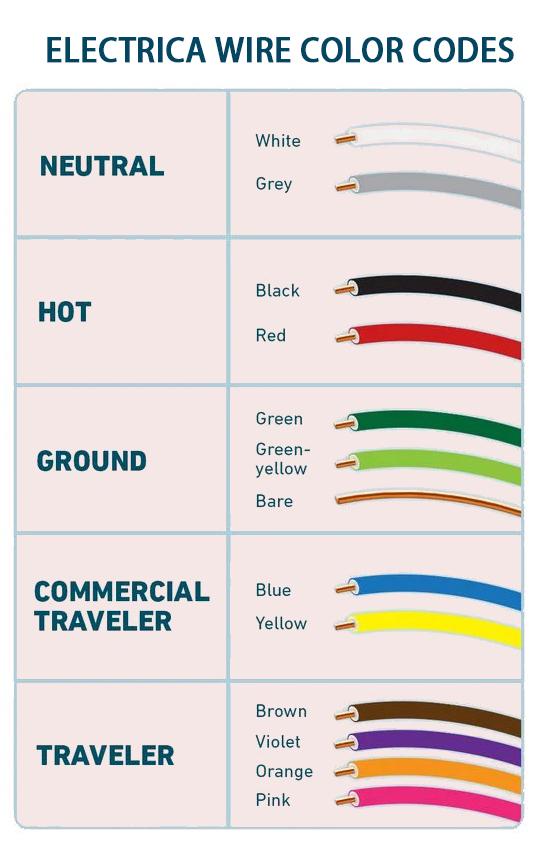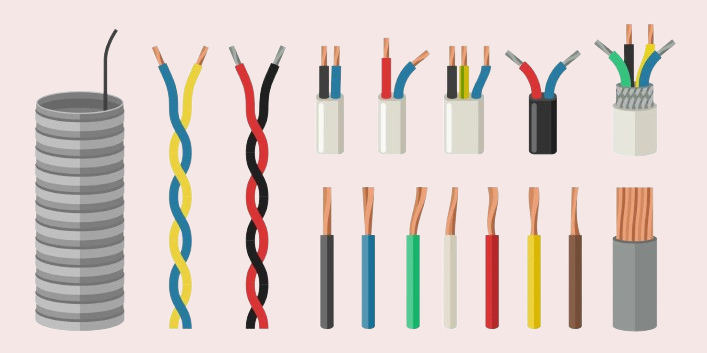Wiring Color Codes Explained: The Right Guide for Homeowners and DIYers
Author:admin Date: 2025-06-11 10:04 Views:612
Have you ever noticed that different wires in an electrical system have different colors. Depending on your location and country, there are different types of wiring colors you may notice. Examples include black, red, green, brown, yellow, and others. It all depends on the color codes that your country follows.
What are Wiring Color Codes?

These are standardized systems used to identify the purpose of each electrical wire. Once they are set up, you can easily troubleshoot and maintain electrical systems.
You can imagine touching a live wire and thinking it is ground because the electrician did not follow the color code when wiring the electrical system. Safety is key in ensuring the electrical wiring color code is followed.
Importance of Wiring Color Codes
Color codes for wiring electrical systems remain important in any country. That is why electricians must always adhere to these codes. Here are more reasons why these codes remain crucial.
Safety
You can be assured that a system wired using the right wiring color codes will be safe for troubleshooting. In most standard electrical systems, black or red means the wire is hot, white or gray means neutral, and green or yellow means ground.
Prevents Mistakes
You can easily identify the function of a wire just from its color code. This reduces the chances of making mistakes while wiring the system. Also, while doing maintenance, you would want the wiring color codes to be done correctly to prevent accidents.
Efficiency
When you have the right color-coded wires in electrical wiring, identifying and connecting these wires quickly becomes more efficient. This saves you time and effort so that you can finish the installations faster.
Standard Wiring Color Codes for AC and DC Wiring
Electrical wiring color codes vary from country to country. That is why we have to look at some of the notable wiring codes that many other countries follow. Below, we have categorized the wiring color codes to ensure you better understand what you are getting into.
– United States and Canada
The National Electrical Code (NEC) is responsible for developing electrical wiring color codes in the US. Below are the important wiring color codes you should know about the US system.
AC Wiring – Single Phase
| Color | Purpose |
|---|---|
| Black or Red | Hot or live |
| White or Gray | Neutral |
| Bare Copper or Green | Ground |
AC Wiring – Three Phase
| Color | Purpose |
|---|---|
| Black | L1 |
| Red | L2 |
| Blue | L3 |
| White or Gray | Neutral |
| Bare Copper or Green | Ground |
DC Wiring
| Color | Purpose |
|---|---|
| Red | Positive |
| Black | Negative |
| Bare Copper or Green | Ground (if necessary) |
| White or Gray | Used for negative sometimes |
– United Kingdom and Europe
The UK depends on the IET BS 7671 wiring regulations. The country updated its wiring color codes to align with the IEC standards in 2004. So, the wiring color codes for the UK and Europe regions are the same. Here is what to expect.
AC wiring – Single Phase
| Color | Purpose |
|---|---|
| Brown | Hot or live |
| Blue | Neutral |
| Green/Yellow | Ground |
AC Wiring – Three Phase
| Color | Purpose |
|---|---|
| Brown | L1 |
| Black | L2 |
| Gray | L3 |
| Blue | Neutral |
| Green/Yellow | Ground |
DC Wiring
| Color | Purpose |
|---|---|
| Red | Positive |
| Black or Blue | Negative |
| Green/Yellow | Ground |
Why Wiring Color Codes Change
From time to time, the color codes for wiring are likely to change. This has happened to the European color code for wiring and other countries. But why?
The main reason is to ensure there is consistency in how the colors are applied across different regions. You can see how international harmonization is essential so that when an electrician from one region moves to another region can also easily identify the purpose of different wires with ease.
Also, changes in technologies and wiring configurations require changing the color coding to accommodate new types of systems and circuits.
You may also get new housing wiring codes to help with better visual differentiation than other colors. You should now be able to identify them quickly, even in complex circuits.
How to Identify Wires Safely

So long as you are working with electricity, it is important to keep safety in mind. This ensures you can do your job right and not have to deal with any electrical issues.
- Turn off the power before doing any troubleshooting on a circuit. This helps to ensure less chances of electrocution.
- Visual inspection is also good for knowing which wires are damaged. Look for signs of burning, frays, or exposed connections.
- The household wiring color codes remain essential to consider as they tell you the purpose of each wire based on the color. Common examples include black representing a hot wire, white for neutral, and green for ground. This is expected to vary from one country or region to another. Make sure to familiarize yourself with the color codes of your region.
- Look at the labels and markings on the wires, as they can help identify what each wire does. As much as standard wiring color codes are important, the labels can be key to understanding a wire’s purpose.
- Testing with a multimeter is also recommended. The last thing you want is for the wire to be live while touching it. The multimeter can be used to identify the AC power wiring color codes in the circuit. It can show the wires’ voltage, current, or resistance. A tester screwdriver can detect voltage in a live wire if you do not have a multimeter.
Mistakes to Avoid with Wiring Color Codes
The electrical wiring color code in the USA or any other region should always be followed to avoid electrocution and other damages. The first mistake would not be to follow such color codes. Below are other mistakes for you to avoid.
Confusing the wires
You might wonder how someone confuses these wires. You might be unsure of a region’s housing wiring color codes or if it is an older home with a different wiring code than what you are used to as the new wiring code.
Before working on an electrical system, you can always consider using a voltage tester to find the live wires. This helps avoid potential electrocution or mixing of the hot and neutral wires.
Ignoring ground wires
The standard wiring color codes have ground wires, which are important for safety. They are mostly green, yellow, or bare copper. They direct the electricity away into the ground in case there is a fault. So, you cannot neglect grounding the circuit, as it is an important safety feature.
Mixing colors
The last thing you should do when it comes to electrical wiring color codes in Canada or any other country is to mix the colors. It is key that you stick to the standard color codes. Mixing the color codes may lead to confusion if someone else troubleshoots and maintains the electrical system.
Using the wrong tools plus protective gear
Depending on the type of electrical system, the right tools are essential. People who use the wrong tools or lack protective gear while installing or maintaining often face issues such as electrocution. Consider getting insulated screwdrivers and pliers while working with electrical wiring.
Not testing the system
Testing a system is the only way to know it is working correctly. It is vital always to test the circuit after installation and catch any errors in wiring you might have made. This helps prevent potential damage to a load when connected in the future.
When to Call a Licensed Electrician for Wiring Applications

You do not always have to work on the electrical system when you are unsure what you are doing. For the best maintenance, you need a licensed electrician who understands house wiring color codes. Here are the signs you need to get a professional electrician involved.
- Flickering or dimming lights often indicate an overload in the circuit or the wiring is not secure.
- The outlets’ discoloration or burn marks can also indicate faulty wiring, short circuits, or overloaded wiring.
- Another popular reason to call an electrician is because there is a burning smell or smoke from an outlet or in the electrical system. It often requires immediate attention as it can lead to an electrical fire.
- There can also be a humming or buzzing sound, which indicates a problem with the electrical wiring.
- Sparking from appliances or fixtures is never a good sign. If not fixed immediately, it can lead to fires.
Conclusion
The standard color code for electrical wiring remains an important consideration whenever working on a project. Without the correct color code in place, it might lead to issues later on, especially when you need to do maintenance. Since electrical work can be dangerous, it is best to consider hiring a licensed electrician who understands the wiring color codes so that troubleshooting and wiring can be done correctly. Remember that color codes may vary from one region to another. As such, always keep yourself updated on these color codes.
Please send RFQ , we will respond immediately.
Frequently Asked Questions
Are the wiring color codes the same in different countries?
No. Each country can have its wiring color code standards. For example, in the US, black is used for live wires, while in the UK, it uses brown. So, it is best to understand the country’s color codes before working on their electrical systems.
Should I just use any colored wire so long as it is installed correctly?
We do not recommend that since the electrical codes specify how to wire a system. This helps avoid confusion and ensures better safety for the next person who comes to troubleshoot or maintain the system.
Are the wiring color codes updated over time?
Yes. It is common for the wiring color codes to need to be changed after several years. When this happens, electricians are expected to be trained in the new codes so that they can use them for newer installations.


